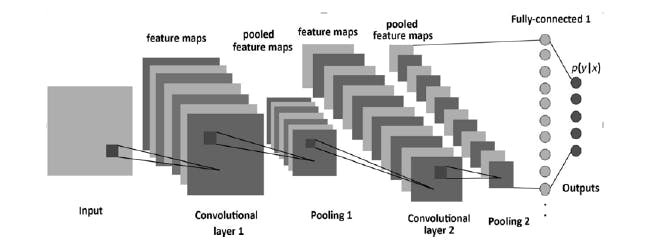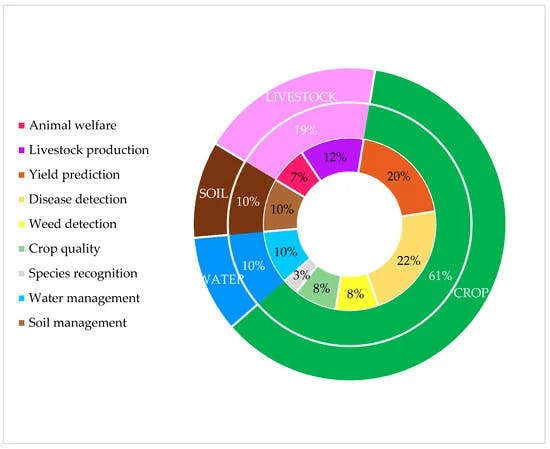Artificial Intelligence in Agriculture : Role of AI & Deep Learning in Agriculture
Artificial Intelligence is an emerging technology in the field of agriculture. AI-based equipment and machines, has taken today's agriculture system to a different level. In recent years, Deep Learning(DL), such as the algorithms of Convolutional Neural Networks, Recurrent Neural Networks and Generative Adversarial Networks, has been widely studied and applied in various fields including agriculture. Researchers in the fields of agriculture often use software frameworks without sufficiently examining the ideas and mechanisms of a technique. This article provides a concise summary of major DL algorithms, including concepts, limitations, implementation, training processes, and example codes, to help researchers in agriculture to gain a holistic picture of major DL techniques quickly. Research on DL applications in agriculture is summarized and analyzed, and future opportunities are discussed in this paper, which is expected to help researchers in agriculture to better understand DL algorithms and learn major DL techniques quickly, and further to facilitate data analysis, enhance related research in agriculture, and thus promote DL applications effectively.
When Comes Machine Automation of Tasks, Deep Learning Plays an Important Part in it.Everything becomes automation to avoid human Contact ,Error and to work Efficiently and so on. Deep Learning is part of computer science's motive to make machine learn from itself by Experience without hard coding it. Most of the Domain Researchers make Deep Learning models to improve humans mostly in medicine. It helps a lot.deep learning algorithms can be overkill for less complex problems because they require access to a vast amount of data to be effective. Deep learning constitutes a recent, modern technique for image processing and data analysis, with promising results and large potential. As deep learning has been successfully applied in various domains, it has also recently entered the domain of agriculture. Farmers analyze data from their machines, from their fields, and even from satellite imagery to help them be more efficient and accurate with their use of natural resources, such as water, soil, and fuel, as well as their use of inputs, such as fertilizer and crop protection products.
Top Applications of Deep Learning Across Industries
Self Driving Cars.
News Aggregation and Fraud News Detection.
Natural Language Processing.
Virtual Assistants.
Entertainment.
Visual Recognition.
Fraud Detection.
Healthcare.
Now it's entered in Modern Agriculture.maybe in the future 5- 10 years it will be used worldwide.In the future, AI will help farmers evolve into agricultural technologists, using data to optimize yields down to individual rows of plants
Agricultural robots automate slow, repetitive and dull tasks for farmers, allowing them to focus more on improving overall production yields. Some of the most common robots in agriculture are used for: Harvesting and picking.Since the beginning of the 21st century, artificial intelligence has been increasingly used in agriculture. AI companies are developing robots that can easily perform multiple tasks in farming fields. This type of robot is trained to control weeds and harvest crops at a faster pace with higher volumes compared to humans.
One of The indicators of growth is the number of published scientific papers dealing with this topic.

The development of artificial intelligence and machine learning in the last two decades has led to a significant increase in the number of projects in the field of agriculture. Artificial intelligence is a general term that includes machine learning, neural networks and deep learning.
Analyzing crop health by drones: SkySquirrel Technologies has brought drone-based Aerial imaging solutions for monitoring crop health. In this technique, the drone captures data from fields and then data is transferred via a USB drive from the drone to a computer and analyzed by experts.
Use of weather forecasting: With the change in climatic condition and increasing pollution it’s difficult for farmers to determine the right time for sowing seed, with help of Artificial Intelligence farmers can analyze weather conditions by using weather forecasting which helps they plan the type of crop can be grown and when should seeds be sown.
Soil and crop health monitoring system: The type of soil and nutrition of soil plays an important factor in the type of crop grown and the quality of the crop. Due to increasing, deforestation soil quality is degrading and it’s hard to determine the quality of the soil.
A German-based tech start-up PEAT has developed an AI-based application called Plantix that can identify the nutrient deficiencies in soil including plant pests and diseases by which farmers can also get an idea to use fertilizer which helps to improve harvest quality. This app uses image recognition-based technology. The farmer can capture images of plants using smartphones. We can also see soil restoration techniques with tips and other solutions through short videos on this application.
Precision Farming and Predictive Analytics: AI applications in agriculture have developed applications and tools which help farmers inaccurate and controlled farming by providing them proper guidance to farmers about water management, crop rotation, timely harvesting, type of crop to be grown, optimum planting, pest attacks, nutrition management.
Research on Modern Agriculture:
Smart agriculture, comprising precision agriculture, digital agriculture, and other new concepts in agricultural research and practice, has gained increasing attention in recent years due to the rising importance of sustainable food production and resource management, as well as to the opportunity offered by the emergence of several digital hardware and software technologies. Accordingly, the development of geospatial, information technology, Internet of Things, robotics, artificial intelligence, and data analytics applications plays an essential role in modern farm management. Traditional approaches of information and knowledge collection for the monitoring of agricultural fields is laborious, time-consuming, and may contain uncertainties. Therefore, technological advances in remote sensing platforms and sensors, digital web applications, and cloud data storage and management centers, as well as the development of intelligent data analysis methods and decision support systems, have improved the quality of monitoring of agricultural lands in order to meet agricultural requirements. Smart agriculture, based on today’s variable-rate technology, geospatial technology, sensor technology, Internet of Things, open-source data and algorithms, machine learning (e.g., deep learning), and high-performance computing can benefit from these opportunities and can address the new food production challenges related to cropping system optimization for improving productivity and reducing environmental impacts. In order to detect a lot of plant features, image recognition can be used which is why CNN has widely been used for weed detection and plant classification. In 2017, to control and classify weed, a new method consisting of CNN and K-means feature learning was developed. The new method increased the accuracy of weed identification to 92.89% . AlexNet is a pre-trained CNN architecture, which is commonly employed for classifying plants. The results of using this architecture at the Istanbul Technical University show that CNN is better than other machine learning algorithms based on handcrafted features for the discrimination of phenological stages.
CNN Architecture:
 CNN is a DL based algorithm the main use of which is natural language processing, speech recognition, face recognition and so on. It has convolutional and pooling layers, which are used for feature extraction while the fully connected layers serve as classifiers.
Most of the recent technological achievements in the field of agriculture are related to production and other areas of agriculture in an attempt to improve crop productivity, minimize plant diseases and improve modern automated agriculture. Data classification and image recognition are what DL is usually used for. These two areas can be divided into the following categories: data collection and preprocessing,model testing, neural network training, and the analysis of the result.
For the first task, DL can be used in conjunction with other technologies such as radar, unmanned aerial vehicles, and Internet of Things, to provide image datasets of high quality. The DL applications are enhanced by these data making the resulting instruments more accurate.
CNN is a DL based algorithm the main use of which is natural language processing, speech recognition, face recognition and so on. It has convolutional and pooling layers, which are used for feature extraction while the fully connected layers serve as classifiers.
Most of the recent technological achievements in the field of agriculture are related to production and other areas of agriculture in an attempt to improve crop productivity, minimize plant diseases and improve modern automated agriculture. Data classification and image recognition are what DL is usually used for. These two areas can be divided into the following categories: data collection and preprocessing,model testing, neural network training, and the analysis of the result.
For the first task, DL can be used in conjunction with other technologies such as radar, unmanned aerial vehicles, and Internet of Things, to provide image datasets of high quality. The DL applications are enhanced by these data making the resulting instruments more accurate.
There is a big number of agricultural applications not supporting new techniques, which means that agriculture still has a lot to explore in terms of DL. Despite the fact that some results indicate 95% accuracy, reliability and robustness remain major challenges.
List Of Pre-Trained Models :
ResNet.
SegNet.
ZFNet.
VGG.
INCEPTIONv3.
AlexNet.
Fast R-CNN.
YoloV3.
EfficentNet.
GoogleNet.
RetinaNet.


- Conclusion Artificial Intelligence in agriculture not only helps farmers to automate their farming but also shifts to precise cultivation for higher crop yield and better quality while using fewer resources.Companies involved in improving machine learning or Artificial Intelligence-based products or services like training data for agriculture, drones, and automated machine making will get technological advancement in the future will provide more useful applications to this sector helping the world deal with food production issues for the growing population. Around 272 deep learning startups impacting agriculture by analysis of startus-insight.com
 Pie chart presenting the papers according to the application domains.
Pie chart presenting the papers according to the application domains.
